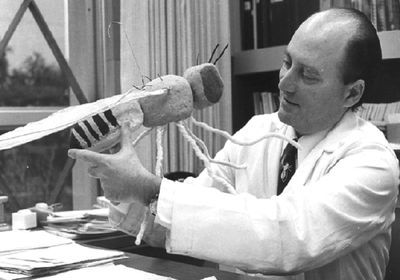ABOVE: Seymour Benzer, shown here holding a large Drosophila model, was one of the pioneers of the tRNA field. William A Harris
Between 10 to 15% of all genetic diseases have the same underlying cause: a nonsense mutation.1 This type of mutation results from a stop codon in the middle of a gene sequence, which terminates translation prematurely and leads to half-finished proteins. Instead of trying to develop cures for these diseases one by one, some scientists and start-up companies now believe that a single drug could target and fix the nonsense mutations in many diseases at once. That drug is a nonsense suppressor tRNA.
Nonsense suppressor tRNAs, or sup-tRNAs, read through premature stop codons in the mRNA caused by nonsense mutations, allowing protein synthesis to continue. It’s easy to see how that might make a handy therapy, and although it has only recently appeared on the biotech radar, it’s an idea that stretches back to the very beginnings of the RNA biology field. “This research has been going on forever, really since understanding translation,” said physiologist John Lueck who researches sup-tRNAs at the University of Rochester.
Retired RNA biologist Uttam RajBhandary, formerly of Massachusetts Institute of Technology (MIT), remembers the beginning of that research. “It all happened in the early to mid-1960s,” he said, recalling the three geneticists then driving the field: Sydney Brenner at the University of Cambridge, Alan Garen at Yale University, and Seymour Benzer at the University of Purdue. Two of their experiments in 1962 were particularly important: one revealed that nonsense codons of bacteriophage mutants were suppressed in some bacterial hosts but not in others,2 and the other showed that a nonsense mutation in one E. coli strain could be overruled by a “suppressor mutation” in a different strain.3
20 years ago, I was literally dreaming about how [tRNAs] could be applied.
—Caroline Köhrer, Alltrna
“In other words, you have a mutation in a gene that you put in E. coli A and it doesn’t produce any protein,” said RajBhandary. “But if you put it into E. coli B, it will now produce the protein. So, E. coli B has something that suppresses the effect of the original nonsense mutation.”
Benzer had previously documented tRNAs as “adaptors” of mRNA to amino acids,4 so he suggested that they might play a role. That suspicion was confirmed three years later when Mario Capecchi and Gary Gussin, then at Harvard University, identified a nonsense codon suppressing tRNA in a bacteriophage.5
“These bacteria and phages actually use them regularly, often as part of a stress response,” said Caroline Köhrer, an RNA scientist who worked alongside RajBhandary for 20 years at MIT. She is now at Alltrna, a biotechnology company working on sup-tRNAs. “In the 1960s and 1970s, there was a quite a bit of work on naturally occurring tRNAs, but of course, that is quite different from something you can use as a therapy.”
In 1982, researchers finally attempted to use sup-tRNAs against a disease.6 At the University of California, San Francisco, geneticist and hematologist Yuet Wai Kan wanted to treat a version of the blood disorder β-thalassemia caused by a nonsense mutation. To try and fix the mutation, he and his team mutated a human tRNA gene in a phage/E. coli system to produce a sup-tRNA and injected it into a frog ovary cell carrying a β-thalassemia patient’s mRNA. “They saw that the tRNA could actually correct the β-thalassemia,” RajBhandary said.
Despite this early success, sup-tRNA therapy did not take off. “[It] was this concern that natural termination codons would be suppressed, and that would be toxic,” Lueck said. “Does [sup-tRNA] really do that? That answer is no.” He and his colleagues demonstrated as much in 2019,1 showing that sup-tRNA readthrough of natural stop codons was minimal compared to that of premature stop codons, likely due to extra termination context in the mRNA sequence around natural stops.
That wasn’t the only hurdle, however. RNA synthesis is tricky, and the products degrade easily. Additionally, Köhrer said, fifteen years ago, researchers were still asking fundamental questions about the details of tRNA nonsense suppression. With advances in genome sequencing and mass spectrometry, those questions became easier to answer, catapulting the field forwards.
To someone like Köhrer, seeing Alltrna’s preclinical mouse work and finally appearing to stand on the cusp of viable tRNA therapeutics gives immense satisfaction. “20 years ago, I was literally dreaming about how [tRNAs] could be applied,” she said. “Imagine my absolute joy and excitement when I think about today.”
References
- Lueck JD, et al. Engineered transfer RNAs for suppression of premature termination codons. Nat Commun. 2019;10(1):822.
- Benzer S, Champe SP. A change from nonsense to sense in the genetic code. Proc Natl Acad Sci USA. 1962;48(7):1114-1121.
- Garen A, Siddiqi O. Suppression of mutations in the alkaline phosphatase structural cistron of E. coli. Proc Natl Acad Sci USA. 1962;48(7):1121-1127.
- Chapeville F, et al. On the role of soluble ribonucleic acid in coding for amino acids. Proc Natl Acad Sci USA. 1962;48(6):1086-1092.
- Capecchi MR, Gussin GN. Suppression in vitro: Identification of a Serine-sRNA as a “Nonsense” Suppressor. Science. 1965;149(3682):417-422.
- Temple GF, et al. Construction of a functional human suppressor tRNA gene: an approach to gene therapy for β-thalassaemia. Nature. 1982;296(5857):537-540.






